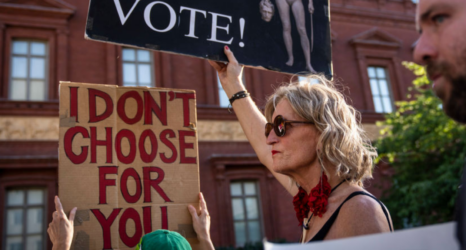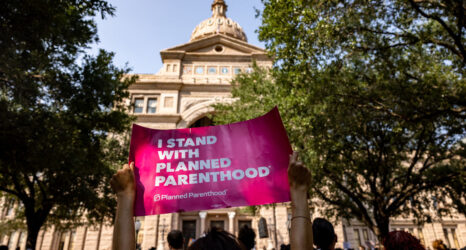On Mother’s Day, President Donald Trump called for “affordable, accessible and quality health care” for women and “[investing] in the comprehensive care that women receive at community health centers.” These are admirable ideas but—when issued from Trump’s mouth—empty goals.
The so-called Trumpcare bill passed by the House in May would cause an estimated 23 million individuals, the majority of them women, to lose their health care and subtract $834 billion from the budget of Medicaid, which provides coverage for children, people with disabilities, lower-income individuals and those aged 65 and older.
“This is the largest transfer of wealth from the poor, the disabled and the elderly to the very rich,” says Eleanor Smeal, president of the Feminist Majority Foundation and publisher of Ms. “The plan includes $874 billion in tax cuts to the highestincome individuals and corporations, and a corresponding $834 billion reduction in Medicaid spending.”
The American Health Care Act (or Trumpcare) repeals and replaces former President Barack Obama’s Affordable Care Act (ACA), commonly known as Obamacare, in ways that are very favorable to the very wealthy. It erases or delays taxes imposed by the ACA on high earners and corporations—taxes that have been used to fund or subsidize health care for the poor, sick, elderly and disabled, the majority of whom are women and children.
Trumpcare steadily reduces federal funding for the Medicaid expansion, eliminating all federal funds by 2020 and leaving 14 million people without Medicaid coverage by 2026. The expansion extended Medicaid benefits to more low-income adults, including new mothers, who previously could become ineligible just 60 days after giving birth. The 11 million people in 31 states and Washington, D.C., who gained coverage through the expansion won’t immediately lose their health care. Indeed, the impact of these changes to Medicaid will not be fully felt until after the next presidential election. After Dec. 31, 2019, the federal government will stop payment for any new expansion enrollees and states will be forced to end the program. The House plan also puts a cap on federal Medicaid (non-expansion) spending. This health care program covers close to 70 million Americans. Under the ACA, the federal government matched state funds according to a state’s Medicaid needs. Trumpcare introduces block grants and per capita spending that will not be sufficient to meet the health care needs of Medicaid recipients, the majority of whom are women. Who else relies on Medicaid? More than 37 million children are enrolled, as well as 64 percent of all nursing home residents. Fifteen percent of Medicaid enrollees are people with disabilities, and one in five senior women supplement Medicare coverage with the program. Trumpcare’s cap on funding denies them all critically needed care.
This piece appears in the Summer 2017 issue of Ms. Subscribe today to get a copy and become a member of the Ms. community!
The House bill ends the employer mandate, meaning there will be no penalty if businesses choose not to pay for employee health insurance. And people insured through the ACA’s marketplace are also at risk of losing health care—Trumpcare ends the cost-sharing subsidies that made insurance more affordable. These subsidies help low-income individuals pay their monthly premiums, deductibles and copays. Trumpcare also ends income-based tax credits, the size of which are currently based on financial need. Under the House plan, there’s a flat tax credit based on age for anyone earning less than $75,000 a year. The maximum tax credit available is $4,000, which does not come close to making insurance affordable for low-income workers. And the majority of low-income workers are women.
The Congressional Budget Office, when it released its analysis of the bill, predicted, “Insurance, on average, would pay for a smaller proportion of health care costs.” Under the ACA, Medicaid expansion programs and health plans offered in the individual market are required to provide 10 essential health benefits, including maternity and newborn care, prescription drugs, chronic disease management and mental health services. Trumpcare does away with these basic benefits for Medicaid recipients, and for private insurance, allows states to opt out of providing essential benefits. These state waivers would threaten coverage for services used exclusively or primarily by women. For example, prior to the ACA, only 12 percent of individually purchased plans covered maternity care, and many plans excluded coverage for mental health conditions such as depression, anxiety or eating disorders. Trumpcare also does away with the ACA’s protections for people with preexisting conditions—allowing states to decide if insurers can once again charge exorbitant amounts for coverage. Prior to the ACA, insurance companies often considered pregnancy or prior cesarean sections or even domestic violence to be pre-existing conditions, basically charging women more for being women.
Trumpcare doesn’t stop there. The bill effectively bans abortion coverage in all marketplace plans (currently 25 states restrict or limit abortion coverage in the ACA marketplaces) and penalizes employers who offer health plans that provide comprehensive abortion care. The House plan would cut off Medicaid payments to Planned Parenthood—which does not use federal funds to provide abortions— for at least one year, jeopardizing lowincome women’s access to birth control, cancer screenings, and STD testing and treatment. More than half of Planned Parenthood health centers are in places where it’s hard to access health care—either because it’s too rural or there’s a shortage of health professionals. Women in these areas will be left without basic services.
But axing Medicaid reimbursements to Planned Parenthood wasn’t enough for Republicans in the House—they’ve also attacked the organization’s Title X funding. The nation’s only federally funded family planning program, it supports health centers that provide women with critical reproductive and preventive care, including breast and cervical cancer screenings and screenings for sexually transmitted infections. Title X-funded clinics assist more than 4 million individuals annually, with Planned Parenthood serving about 1.5 million alone. Excluding family planning providers for reasons unrelated to the care they provide violates federal law. One of the last acts of the Obama administration was to issue a rule clarifying the federal law’s prohibition— on the basis of separation of church and state—on discrimination against abortion providers in the allocation of Title X funding. This final rule sought to preserve the integrity of the Title X program and its purpose.
But shortly after Trump took office, some members of Congress moved to dismantle the rule. Rep. Diane Black (R-Tenn.) introduced a resolution (H.J.Res. 43) concurrently with one from Sen. Joni Ernst (RIowa) that does not change existing federal law but strikes the rule and therefore could “embolden” state discrimination against Title X providers, according to the National Family Planning & Reproductive Health Association. In March, the resolution narrowly passed the House and succeeded in the Senate only after Vice President Mike Pence cast the tie-breaking vote.
Restricting Title X funds from Planned Parenthood clinics would alarmingly diminish women’s access to comprehensive health care. Planned Parenthood clinics often offer evening and weekend hours and on-site pharmacies, which make them more accessible than local health departments or federally qualified health centers. Excluding reproductivehealth providers from publicly funded programs worsens health outcomes, widens health disparities and resurrects barriers to care.
In April, H.J.Res. 43 was signed by President Trump and became law. The Senate is expected to consider and vote on an ACA repeal package this summer. Trumpcare is opposed by a wide coalition of organizations including the March of Dimes, AARP, American Hospital Association, Catholic Health Association and American Medical Association.
Now is the time to join the resistance. Reach out to your senators.





